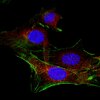OP29 Sigma-AldrichAnti-p53 (Ab-3) (Mutant) Mouse mAb (PAb240)
This Anti-p53 (Ab-3) (Mutant) Mouse mAb (PAb240) is validated for use in FC, Frozen Sections, Gel Shift, Immunoblotting, IF, IP, Paraffin Sections for the detection of p53 (Ab-3) (Mutant).
More>> This Anti-p53 (Ab-3) (Mutant) Mouse mAb (PAb240) is validated for use in FC, Frozen Sections, Gel Shift, Immunoblotting, IF, IP, Paraffin Sections for the detection of p53 (Ab-3) (Mutant). Less<<Anti-p53 (Ab-3) (Mutant) Mouse mAb (PAb240) MSDS (material safety data sheet) or SDS, CoA and CoQ, dossiers, brochures and other available documents.
Recommended Products
概述
| Replacement Information |
|---|
重要规格表
| Species Reactivity | Host | Antibody Type |
|---|---|---|
| B, Ch, Ht, H, M, R | M | Monoclonal Antibody |
价格及供货情况
| 产品目录编号 | 库存情况 | 包装 | 数量 / 包装 | 价格 | 数量 | |
|---|---|---|---|---|---|---|
| OP29-100UGCN |
|
塑胶安瓿;塑胶针药瓶 | 100 μg |
|
— | |
| OP29-200UGCN |
|
塑胶安瓿;塑胶针药瓶 | 200 μg |
|
— |
| Product Information | |
|---|---|
| Form | Liquid |
| Formulation | In 50 mM sodium phosphate buffer, 0.2% gelatin, pH 7.5. |
| Negative control | SK-OV-3 cells |
| Positive control | A431, Hs27 (wild-type p53), or SK-BR-3 cells or breast carcinoma tissue |
| Preservative | ≤0.1% sodium azide |
| Quality Level | MQ100 |
| Physicochemical Information |
|---|
| Dimensions |
|---|
| Materials Information |
|---|
| Toxicological Information |
|---|
| Safety Information according to GHS |
|---|
| Safety Information |
|---|
| Product Usage Statements |
|---|
| Storage and Shipping Information | |
|---|---|
| Ship Code | Blue Ice Only |
| Toxicity | Standard Handling |
| Storage | +2°C to +8°C |
| Do not freeze | Yes |
| Packaging Information |
|---|
| Transport Information |
|---|
| Supplemental Information |
|---|
| Specifications |
|---|
| Global Trade Item Number | |
|---|---|
| 产品目录编号 | GTIN |
| OP29-100UGCN | 07790788053888 |
| OP29-200UGCN | 04055977208429 |
Documentation
Anti-p53 (Ab-3) (Mutant) Mouse mAb (PAb240) MSDS
| 职位 |
|---|
Anti-p53 (Ab-3) (Mutant) Mouse mAb (PAb240) 分析证书
| 标题 | 批号 |
|---|---|
| OP29 |
参考
| 参考信息概述 |
|---|
| El-Deiry, W.S., et al. 1994. Cancer Res. 54, 1169. Greenblatt, M.S., et al. 1994. Cancer Res. 54, 4855. Barak, Y., et al. 1993. EMBO J. 12, 461. Kastan, M.B., et al. 1992. Cell 71, 587. Kuerbitz, S.J. 1992. Proc. Natl. Acad. Sci. USA 89, 7491. Lane, D.P. 1992. Nature 358, 15. Kastan, M.B., et al. 1991. Cancer Res. 51, 6304. |
小册子
| 标题 |
|---|
| Caspases and other Apoptosis Related Tools Brochure |













